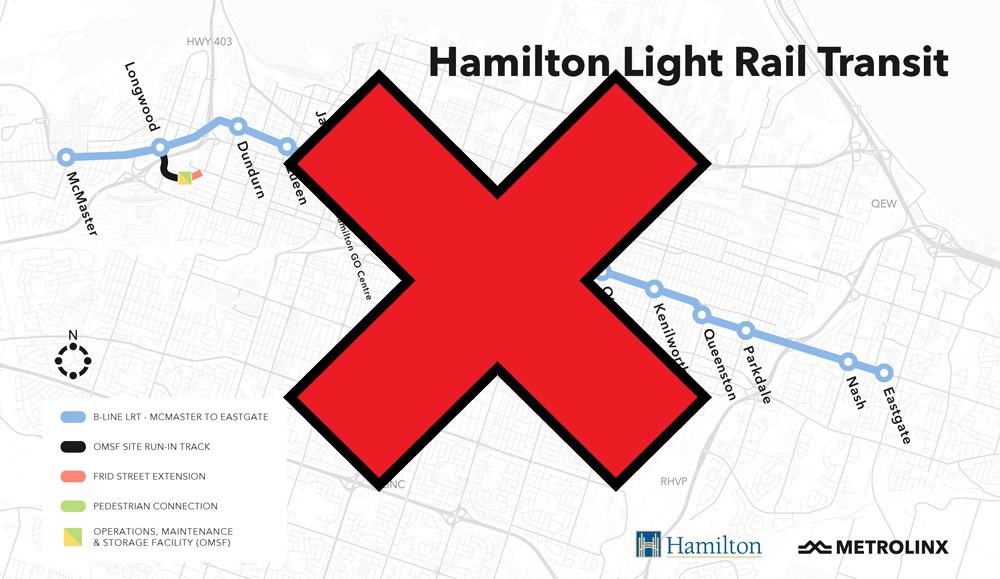OPINION: Is LRT dead in Ontario with Hamilton LRT cancellation?
Published December 18, 2019 at 4:10 am

The sudden news of Hamilton’s LRT being cancelled by the Doug Ford government is, to say the least, one of the shocking bits of news the city has experienced in the last few weeks.
The sudden news of Hamilton’s LRT being cancelled by the Doug Ford government is, to say the least, one of the shocking bits of news the city has experienced in the last few weeks.
First, it was the revelation that city council failed to properly notify the public that approximately 24-billion litres of stormwater runoff and sewage were discharged into Chedoke Creek over a span of more than four years.
After seven fatalities since 2012, an inquiry into the Red Hill Valley expressway is costing the city almost $640,000, according to the report before the GIC this week. The cost, the report says, is to be paid from the Tax Stabilization Reserve.
Now it has come to this: the cancellation of a project that would run through the urban city core of Hamilton, providing much-needed transit and the spark to revitalize a city whose economy has taken a beating in the past several decades.
Despite the announcement of the LRT’s cancellation, Transportation Minister Caroline Mulroney said the city is still getting about $1 billion for other transit infrastructure projects. Those projects have yet to be confirmed, with Mulroney saying a task force will be set up to identify specific projects around February.
This hasn’t stopped various Hamilton city councillors from declaring that the LRT is not dead, with Ward 3 Coun. Nrinder Nann asking for an emergency council meeting to pass a motion asking the federal government for money and having City Council confirm their commitment to the LRT.
Others were more scathing in their views towards the province. Ward 8 Coun. John-Paul Danko essentially said the province “cooked the books,” to get the outcome they desired and an impassioned Ward 1 Coun. Maureen Wilson asked when governments would stop pedalling their “populist snake oil.”
Ford, who rose to power on a wave of discontentment towards the former Liberal government, styles himself as a ‘populist’ (for the people) and said he would not interfere with the democratic decision Hamiltonians made last year when they reelected Mayor Fred Eisenberger, a vocal LRT supporter.
Depending on who you talk to, Ford has kept his promise to listen to the people…as in, the people who were against the LRT. Or he flatly broke his promise to Hamiltonians, who have been clamouring for something positive to happen to their city.
But let’s unpack the wider issue at play here. Is LRT (light rail transit) dead in Ontario?
You might think that, with Ford’s past of railing against LRTs as ‘glorified streetcars’ in favour of subways, but the issue is a bit more complicated nowadays.
The Eglinton Crosstown LRT is scheduled for completion by 2021 and with all the construction and disruption to traffic already taking place, not finishing that project and trying to put things back the way they were would be detrimental to progress…not to mention future business.
The same could be said for the Hurontario LRT, albeit it has since been slightly modified to remove a ‘loop’ around the Mississauga Square One area, although a connection to the main transit hub from the mall is planned.
LRT systems are already up and running in Kitchener-Waterloo and Ottawa, although the latter has experienced operational issues since it opened.
Stripping away any issues with the cost or cost overruns, is Hamilton really a jurisdiction where an LRT could work? There’s been enough noise (mostly on the negative side) made about Brampton and Mississauga, two of the most car centric communities in Canada, getting light rail transit. But the LRT that was slated for Hamilton would primarily run through the old city from the west in McMaster to Eastgate, and if you are familiar with urban and downtown Hamilton, it really was never designed for the car.
Old Hamilton was designed in more of the traditional way a city developed prior to the post-war period when the demand was for more suburban living. Back then, the city was designed more for walkability and pedestrian environment than funnelling in cars.
Likewise, in Kitchener Waterloo and Ottawa they have growing dynamic urban cores and outlying communities, not to mention smaller populations, where an LRT could effectively serve as that means for people to get from places of work, leisure and back home again.
The overall point is LRT is only a piece of a number of initiatives that could start shifting the way we plan and build cities in the future back towards a model that is more pedestrian-friendly, that respects the space of the driver, the person walking / biking and those taking public transit.
But unless there is a viable alternative the province was willing to put in place, cancelling public transit projects sets a bad precedent (especially for a government that likes Ontario to be ‘open for business’) and is not the way to go.
Photo courtesy of City of Hamilton / Metrolinx
insauga's Editorial Standards and Policies advertising





